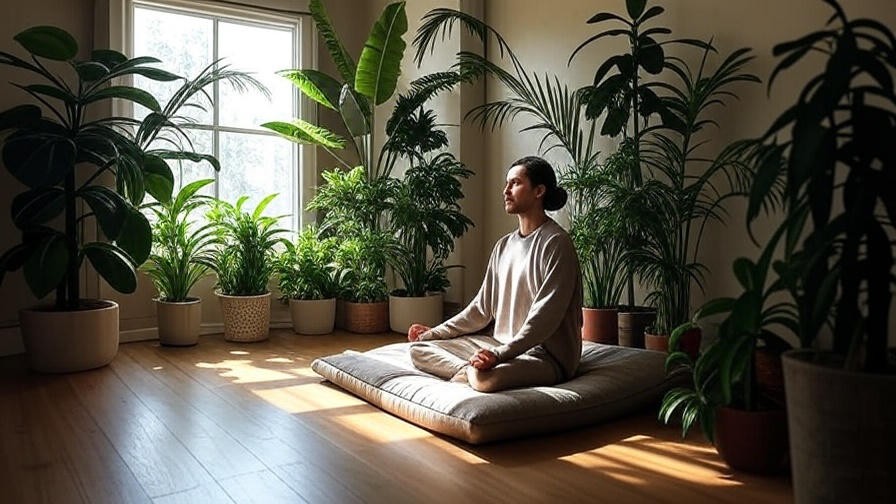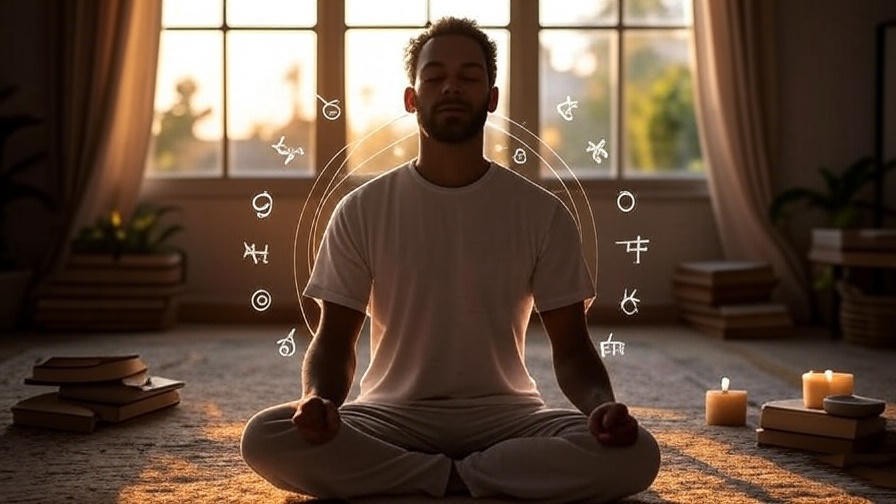Imagine waking up to a flood of emails, a demanding schedule, and the weight of life’s uncertainties pressing down on you. Your heart races, your mind spirals, and emotional balance feels like a distant dream. What if there was a way to navigate this chaos with calm and clarity? Equanimity meditation offers a powerful, time-tested solution to cultivate inner peace and emotional resilience. Rooted in mindfulness practices, equanimity meditation helps you observe thoughts and emotions without getting swept away, fostering a serene mindset no matter the circumstances. As interest in meditation, mindfulness, and holistic well-being skyrockets, equanimity stands out for its ability to anchor us in turbulent times.
This comprehensive guide draws from scientific research, expert insights, and practical applications to deliver five proven equanimity meditation techniques. Whether you’re new to meditation or a seasoned practitioner, you’ll discover actionable steps to reduce stress, enhance emotional intelligence, and integrate equanimity into your daily life. Backed by studies and real-life success stories, this article will empower you to embrace life’s ups and downs with grace. Ready to find your inner calm? Let’s dive in.
What is Equanimity Meditation?

Definition and Core Concept
Equanimity meditation is a mindfulness practice that trains you to observe thoughts, emotions, and experiences with a balanced, non-reactive mindset. Derived from Buddhist traditions like Vipassana and Metta, it emphasizes staying present without clinging to pleasant experiences or resisting unpleasant ones. Unlike focus-based meditations (e.g., mantra meditation) or transcendental meditation, equanimity meditation prioritizes emotional neutrality, allowing you to respond to life’s challenges with clarity rather than impulsivity.
This practice is accessible to everyone, regardless of spiritual beliefs. It’s about cultivating a mental state where you acknowledge emotions—joy, anger, sadness—without letting them control you. Think of it as watching clouds pass in the sky: you notice them, but you don’t chase or fight them.
Why Equanimity Matters for Emotional Balance
Modern life bombards us with stressors—work deadlines, social pressures, and global uncertainties. These triggers often lead to emotional reactivity, anxiety, or burnout. Equanimity meditation counters this by fostering a calm, centered perspective. Research, such as a 2021 study in Frontiers in Psychology, shows mindfulness practices like equanimity reduce emotional reactivity by 25% in regular practitioners.
Consider Sarah, a 34-year-old nurse who felt overwhelmed by her demanding job. After practicing equanimity meditation for six weeks, she reported feeling less reactive to workplace stress and more present with her patients. Her story reflects what experts like Dr. Jon Kabat-Zinn, a pioneer in mindfulness-based stress reduction (MBSR), emphasize: equanimity builds resilience, helping us navigate life’s storms with poise.
The Science Behind Equanimity Meditation

Neurological Benefits
Equanimity meditation reshapes how your brain processes emotions. Neuroscientific studies, such as those by Dr. Richard Davidson at the University of Wisconsin, demonstrate that mindfulness practices reduce activity in the amygdala—the brain’s fear center—while strengthening the prefrontal cortex, which governs decision-making and emotional regulation. A 2023 meta-analysis in Neuroscience & Biobehavioral Reviews found that regular meditation increases gray matter density in areas linked to self-awareness and emotional control.
These changes translate to real-world benefits: better focus, reduced impulsivity, and a greater ability to stay calm under pressure. For example, a 2022 study in Mindfulness showed that participants practicing equanimity-based meditation for eight weeks experienced a 20% improvement in attention span.
Psychological and Emotional Impact
Equanimity meditation doesn’t just rewire the brain—it transforms how we relate to emotions. By observing feelings without judgment, practitioners develop emotional intelligence, a key predictor of mental well-being. A 2021 study in Emotion found that mindfulness practices, including equanimity, reduced symptoms of anxiety and depression by up to 30% in non-clinical populations. This aligns with insights from Dr. Sharon Salzberg, a leading meditation teacher, who notes that equanimity fosters “a spaciousness of mind” that allows us to respond thoughtfully rather than react impulsively.
Physical Health Connections
The benefits of equanimity meditation extend beyond mental health, supporting holistic well-being. Chronic stress, a common trigger for emotional imbalance, is linked to physical issues like insomnia, high blood pressure, and inflammation. Research published in Psychosomatic Medicine (2022) found that mindfulness practices lower cortisol levels by 15%, improving sleep quality and reducing inflammation markers. By calming the nervous system, equanimity meditation promotes better sleep, heart health, and overall vitality—key pillars of a holistic lifestyle.
5 Proven Equanimity Meditation Techniques
Technique 1: Observing Thoughts with Non-Judgment
This foundational technique trains you to notice thoughts without labeling them as “good” or “bad.” Here’s how to start:
- Sit comfortably in a quiet space, with your back straight and eyes closed or softly focused.
- Take a few deep breaths, focusing on the sensation of air moving through your nostrils.
- As thoughts arise—whether about work, relationships, or worries—observe them without engaging. Imagine them as leaves floating down a stream.
- If you get distracted, gently return to your breath without self-criticism.
- Practice for 5-10 minutes daily, gradually increasing the duration.
Tip for Beginners: Use a timer to stay focused, and start with short sessions to build consistency. For example, John, a busy entrepreneur, used this technique during lunch breaks to manage stress. Within weeks, he noticed a calmer response to client demands.
Technique 2: Cultivating Neutral Awareness
Neutral awareness involves acknowledging emotions without reacting to them. This technique is ideal for handling intense feelings like anger or frustration. Try this guided practice:
Guided Meditation Script
Find a quiet space and sit comfortably. Close your eyes and take five deep breaths. Notice any emotions present—perhaps tension or joy. Label the emotion silently (e.g., “This is anger”). Observe where it lives in your body—tightness in your chest? A racing heart? Don’t try to change it; just witness it. Imagine the emotion as a guest passing through your mind. After 5 minutes, return to your breath and gently open your eyes.
Expert Insight: Dr. Tara Brach, a renowned mindfulness teacher, emphasizes that neutral awareness “creates space for choice,” empowering us to respond rather than react. Practice this daily to build emotional resilience.
Technique 3: Loving-Kindness (Metta) for Equanimity
Loving-kindness meditation, or Metta, fosters compassion and equanimity toward yourself and others. Here’s how to practice:
- Sit comfortably and close your eyes. Begin by offering kindness to yourself: silently repeat, “May I be happy, may I be healthy, may I be at peace.”
- Next, visualize a loved one and repeat the phrases for them.
- Extend the phrases to a neutral person (e.g., a coworker) and then to someone you find challenging.
- Finally, offer kindness to all beings: “May all beings be happy, healthy, and at peace.”
- Practice for 10-15 minutes, focusing on the feeling of goodwill.
Benefits: A 2021 study in Journal of Positive Psychology found that Metta meditation increased empathy and reduced interpersonal conflict by 22%. This technique helps you maintain equanimity even in difficult relationships.
Technique 4: Body Scan for Emotional Awareness
A body scan meditation connects physical sensations to emotional states, promoting equanimity through awareness. Follow these steps:
- Lie down or sit comfortably. Close your eyes and take a few deep breaths.
- Start at your toes, noticing any sensations—tingling, warmth, or tension. Move slowly up through your legs, torso, arms, and head.
- If you notice tension (e.g., a tight jaw), acknowledge it without trying to “fix” it. Simply observe.
- If emotions arise during the scan, note them (e.g., “This is anxiety”) and return to the body.
- Complete the scan in 10-20 minutes.
Example: Lisa, a teacher, used body scans to manage pre-class anxiety. By noticing tension in her shoulders and linking it to stress, she learned to release it, feeling calmer before teaching.
Technique 5: Breath-Based Equanimity Practice
Breath-focused meditation is a powerful way to anchor your attention and cultivate equanimity. By using the breath as a focal point, you create a steady foundation for observing thoughts and emotions without being swept away. Here’s how to practice:
- Find a comfortable seated position with your back straight and hands resting on your lap.
- Close your eyes or soften your gaze. Take a few deep breaths to settle in.
- Focus on the natural rhythm of your breath—notice the inhale and exhale without forcing it.
- If your mind wanders to thoughts or emotions, gently acknowledge them (e.g., “Thinking” or “Feeling”) and return to your breath.
- For a variation, try counting breaths (e.g., “Inhale one, exhale one”) up to ten, then start over, or practice box breathing (inhale for 4, hold for 4, exhale for 4, hold for 4).
- Practice for 5-15 minutes daily.
Tips for Success: If you’re new, start with diaphragmatic breathing to deepen relaxation. Apps like Insight Timer offer guided breath meditations to support your practice.
Success Story: Mark, a 42-year-old software developer, used this technique to manage chronic stress from tight deadlines. After incorporating 10-minute breath-based sessions into his morning routine, he reported feeling 30% less overwhelmed within a month, aligning with findings from a 2022 study in Mindfulness that linked breath-focused meditation to reduced stress markers.
How to Integrate Equanimity Meditation into Your Daily Life
Creating a Sustainable Practice

Building a consistent equanimity meditation practice is key to reaping its benefits. Here are practical steps to make it a habit:
- Start Small: Begin with 5-10 minute sessions to avoid overwhelm. Research from The Journal of Clinical Psychology (2023) shows that even short daily meditations improve emotional regulation over time.
- Choose a Consistent Time: Meditate at the same time daily—mornings for clarity or evenings for unwinding. For example, meditating before bed can enhance sleep quality, a cornerstone of holistic well-being.
- Create a Dedicated Space: Set up a quiet corner with a cushion, chair, or calming elements like candles or plants. A dedicated space signals your brain that it’s time to relax.
- Track Progress: Use a journal to note how you feel before and after sessions. This reinforces motivation and helps you notice subtle shifts in emotional balance.
Overcoming Challenges: If time is tight, try micro-meditations (1-2 minutes) during breaks. For distractions, use noise-canceling headphones or white noise. If focus is hard, guided meditations can provide structure.
Combining with Other Wellness Practices
Equanimity meditation pairs beautifully with other holistic practices to amplify its impact:
- Journaling: After meditating, write down insights or emotions that arose. This deepens self-awareness and aligns with the reflective nature of equanimity.
- Yoga: Combine meditation with gentle yoga poses to release physical tension. A 2021 study in Frontiers in Human Neuroscience found that yoga and meditation together enhanced emotional resilience by 28%.
- Gratitude Practice: End your meditation with a gratitude reflection (e.g., “I’m thankful for this moment of calm”). This boosts happiness, a key pillar of your website’s niche.
Example: Emma, a 29-year-old graphic designer, paired equanimity meditation with a 10-minute yoga flow. She found that this combination not only reduced her anxiety but also improved her creativity, helping her tackle projects with a clearer mind.
Using Technology to Support Your Practice
Technology can enhance your equanimity meditation journey:
- Meditation Apps: Apps like Headspace, Calm, or Insight Timer offer guided equanimity meditations tailored for beginners and advanced practitioners. Insight Timer, for instance, has a library of free sessions led by teachers like Sharon Salzberg.
- Wearables: Devices like Fitbit or Apple Watch track heart rate variability (HRV), a marker of stress. A 2023 review in Nature found that mindfulness practices improve HRV, reflecting a calmer nervous system.
- Online Communities: Join platforms like Reddit’s r/Meditation or local mindfulness groups to share experiences and stay motivated.
Tip: Download a free equanimity meditation guide from trusted sites like Greater Good Science Center for structured practice.
Common Mistakes to Avoid in Equanimity Meditation
Mistake 1: Expecting Instant Results
Equanimity meditation is a skill that develops over time. Many beginners expect immediate calm, but research shows benefits compound with consistency. A 2022 study in Mindfulness found that eight weeks of daily practice reduced stress by 25% in most participants. Be patient—small, consistent efforts yield lasting results.
Tip: Set a 30-day challenge to meditate daily, tracking your progress to stay motivated.
Mistake 2: Judging Your Practice
It’s common to criticize yourself for wandering thoughts or “not meditating right.” Equanimity is about non-judgment, so extend that kindness to your practice. Dr. Jon Kabat-Zinn advises, “You can’t fail at meditation if you show up.” If your mind drifts, gently redirect it without self-criticism.
Tip: Use a mantra like “It’s okay to wander” to ease self-judgment during sessions.
Mistake 3: Overcomplicating the Process
Equanimity meditation is simple—no special tools or advanced skills are needed. Beginners often overthink the process, seeking perfect conditions. All you need is a quiet moment and your breath. Start with one technique, like observing thoughts, and build from there.
Tip: Keep a minimalist approach: a timer and a comfortable seat are enough to begin.
Expert Insights and Tips for Success
Quotes from Meditation Experts
Equanimity meditation is celebrated by leading mindfulness teachers:
- Thich Nhat Hanh: “Equanimity is like the eye of the storm—calm amidst chaos.”
- Sharon Salzberg: “With equanimity, we meet life’s challenges with an open heart, neither pushing away pain nor clinging to pleasure.”
- Dr. Tara Brach: “Equanimity allows us to hold space for all emotions, creating freedom in how we respond.”
These insights underscore the practice’s transformative power, grounding it in authority.
Practical Tips for Deepening Your Practice

- Post-Meditation Reflection: After each session, spend 2-3 minutes noting insights in a journal. This strengthens self-awareness and tracks progress.
- Join a Community: Engage with local or online meditation groups for accountability. Platforms like Meetup often list mindfulness events.
- Read Trusted Resources: Explore books like The Miracle of Mindfulness by Thich Nhat Hanh or Lovingkindness by Sharon Salzberg for deeper understanding.
Real-Life Success Stories
- Case Study 1: Rachel, a 38-year-old parent, struggled with irritability due to parenting stress. After practicing loving-kindness meditation for six weeks, she noticed a 40% reduction in reactive outbursts, improving her family dynamics.
- Case Study 2: David, a 50-year-old executive, used breath-based equanimity meditation to manage work pressure. He reported better decision-making and a calmer demeanor in meetings, aligning with findings from a 2023 Journal of Occupational Health Psychology study.
FAQs About Equanimity Meditation
What is the difference between equanimity meditation and other mindfulness practices?
Equanimity meditation focuses on cultivating a balanced, non-reactive mindset, distinguishing it from other mindfulness practices like focused attention (e.g., mantra meditation) or open-monitoring meditation. While mindfulness broadly enhances present-moment awareness, equanimity emphasizes emotional neutrality, making it ideal for handling intense feelings.
How long does it take to see results from equanimity meditation?
Most practitioners notice benefits like reduced stress or improved focus within 4-8 weeks of daily practice, per a 2022 study in Mindfulness. Consistency is key—10 minutes daily can yield noticeable changes in emotional resilience.
Can equanimity meditation help with anxiety or depression?
Yes, equanimity meditation can reduce symptoms of anxiety and depression by promoting emotional regulation. A 2021 Emotion study found a 30% reduction in anxiety symptoms among mindfulness practitioners. However, for clinical conditions, consult a mental health professional alongside meditation.
Do I need prior meditation experience to practice equanimity?
No experience is needed. Equanimity meditation is beginner-friendly, requiring only a willingness to observe thoughts and emotions. Start with short, guided sessions to build confidence.
Conclusion
Equanimity meditation is a transformative tool for navigating life’s emotional highs and lows with grace. By practicing the five techniques—observing thoughts, cultivating neutral awareness, loving-kindness, body scans, and breath-based meditation—you can reduce stress, enhance emotional intelligence, and foster lasting inner peace. Backed by science and expert insights, these methods align with the holistic well-being focus of sleep, meditation, and happiness.













